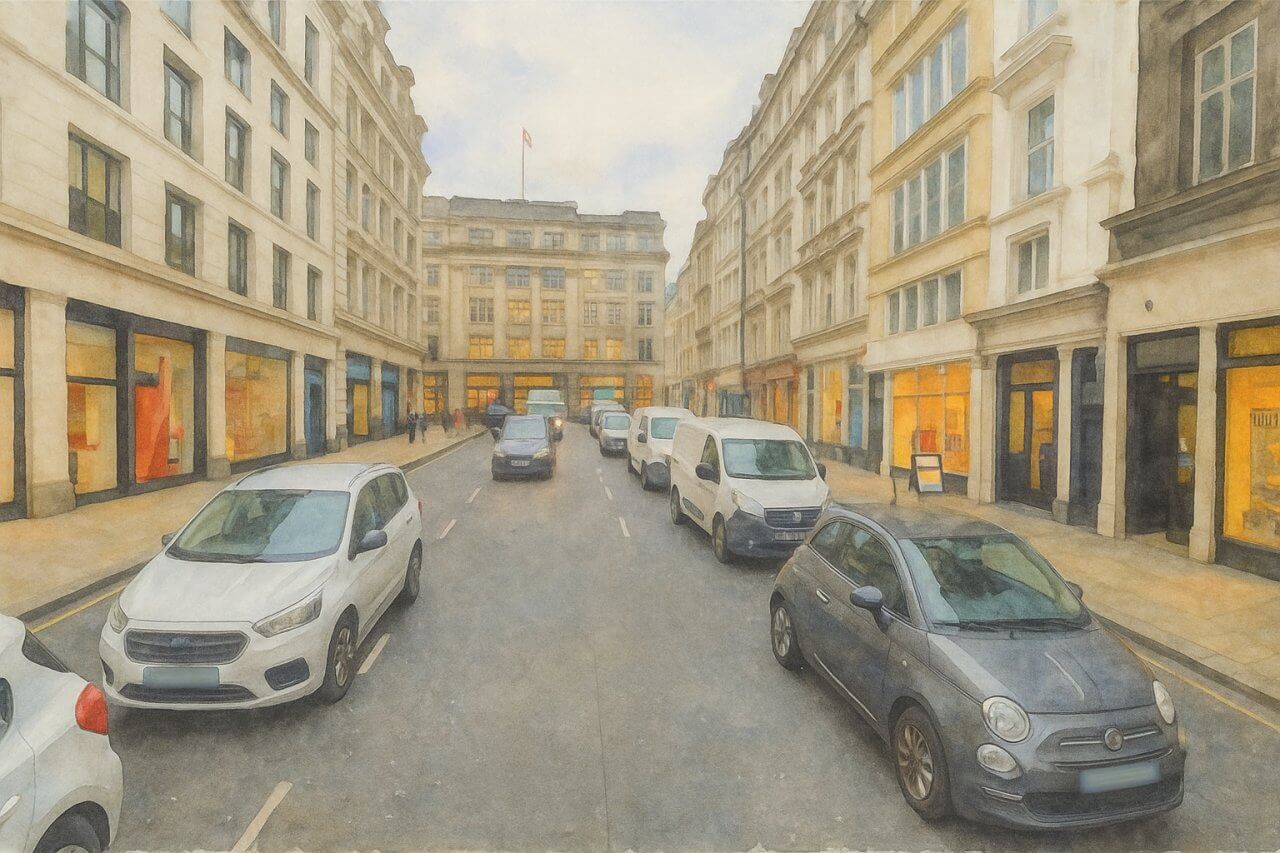
Hanover Street, London
Hanover Street is a short yet historically significant road in the City of Westminster, central London, linking the grand curve of Regent Street to the leafy elegance of Hanover Square. Though it stretches for only 114 metres (374 feet), it forms a vital connection between major retail, commercial, and cultural areas in the heart of the West End.
Location and Layout
Hanover Street runs east-west, beginning at Regent Street and terminating at Hanover Square. The road is one-way, allowing vehicular traffic to flow westward—from Regent Street to Hanover Square. This directionality is typical for short connector streets in busy areas of London, helping to regulate traffic around popular shopping and office districts.
Hanover Square
Hanover Square, which gives the street its name, is one of the oldest squares in Westminster, developed in the early 18th century. The square is laid out in a traditional Georgian pattern, centred around a public garden with mature trees and benches. It is surrounded by stately buildings that now house offices, private clubs, and luxury boutiques.
Other roads feeding into Hanover Square include Brook Street, Princes Street, and Harewood Place. Oxford Street, one of London's busiest shopping streets, is just to the north.
Pronunciation and Name Origin
The street name is pronounced HAN-uh-ver, with the stress on the first syllable. In the International Phonetic Alphabet, it is transcribed as /ˈhænəvə/  .
.
Hanover Street was named after the House of Hanover, the royal house of Great Britain at the time the street was developed in the early 18th century. The name celebrated the accession of King George I in 1714, the first British monarch from the Hanoverian dynasty. Streets named after royal connections were common during this era, particularly in the rapidly developing neighbourhoods of what is now Mayfair.
Historical Context
Hanover Street was laid out in the early 1720s during the expansion of London's West End. Its development coincided with the establishment of Hanover Square, part of an effort to attract affluent residents and nobility to new townhouses away from the crowded City. As the area developed, Hanover Street became a connector for commerce and movement within this increasingly fashionable district.
Street Character and Present-Day Use
Today, Hanover Street retains a refined commercial character, lined with elegant façades and modern retail units. The west end of the street near Regent Street is home to high-end shops, banks, and offices. Despite its short length, it serves as a transitional zone between the grand Regency architecture of Regent Street and the more intimate Georgian surroundings of Hanover Square.
The street is paved with wide pavements and flanked by heritage-style lampposts, giving it a timeless charm. It also features some trees, offering a touch of greenery in an otherwise bustling commercial environment.
Nearby Attractions and Points of Interest
- Regent Street: A globally recognised shopping street with flagship stores like Liberty and Hamleys.
- Hanover Square Gardens: A quiet spot to rest among trees and flower beds.
- Oxford Street: Located just north of Hanover Square, it’s one of Europe's busiest retail districts.
- Royal Academy of Arts: Just a short walk away in Burlington House on Piccadilly.
Real Estate and Property Prices
Properties along Hanover Street and adjacent Hanover Square command high prices, reflecting the area’s prestige. As of early 2025, office spaces along the street lease at around £110–£130 per sq ft (£1,184–£1,399 per sq m) per annum1. Residential properties in nearby Hanover Square can exceed £3,000 per sq ft (£32,292 per sq m), especially in new luxury developments with concierge services and underground parking2.
Typical residential flats in the area range from 1,200 sq ft (111 sq m) for a two-bedroom flat to 3,000 sq ft (279 sq m) for a penthouse apartment.
Transport and Accessibility
Nearest London Underground Stations
- Oxford Circus Station – Bakerloo Line, Central Line, Victoria Line
- Bond Street Station – Jubilee Line, Central Line
- Green Park Station – Piccadilly Line, Jubilee Line, Victoria Line
Bus Stops
The closest bus stops are located along Regent Street and Oxford Street. Routes serving these stops include:
- Route 12 – to Dulwich Library via Trafalgar Square
- Route 94 – to Acton Green via Notting Hill Gate
- Route 22 – to Putney Common via Sloane Square
Fun Fact
Hanover Street was one of the filming locations for the 1979 World War II romantic drama Hanover Street, starring Harrison Ford. Though most of the film is set in wartime London and France, the street’s name and ambience made it the perfect backdrop for key scenes, giving the street a brief but memorable moment in cinema history.
Quick Facts
- Location: City of Westminster, central London
- Length: 114 metres (374 feet)
- Direction of Traffic: One-way westbound
- Connects: Regent Street to Hanover Square
- Nearby Stations: Oxford Circus, Bond Street, Green Park
- Nearby Bus Routes: 12, 22, 94
- Notable Sites: Hanover Square Gardens, Regent Street
- Real Estate Price (2025): £3,000+ per sq ft for residential; £110–£130 per sq ft for office spaces
- Pronunciation: /ˈhænəvə/
- Fun Fact: Featured in a 1979 film starring Harrison Ford
References
Map of Hanover Street, London

Painting of Hanover Street, London (View image in full size)